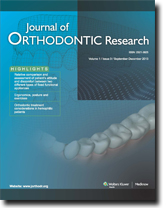 |
September-December 2013
Volume 1 | Issue 3
Page Nos. 83-113
Online since Friday, December 20, 2013
Accessed 19,378 times.
PDF access policy
Journal allows immediate open access to content in HTML + PDF
EPub access policy
Full text in EPub is free except for the current issue. Access to the latest issue is reserved only for the paid subscribers.
|
| |
|
|
Show all abstracts Show selected abstracts Add to my list |
|
| ORIGINAL ARTICLE |
|
|
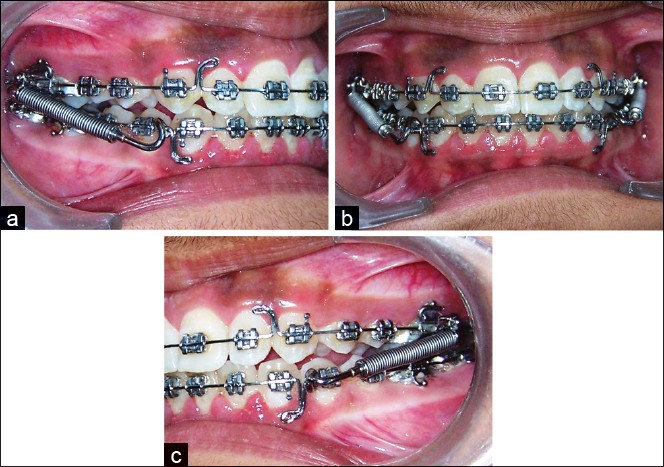  |
Relative comparison and assessment of patient's attitude and discomfort between two different types of fixed functional appliances: A comprehensive survey |
p. 83 |
Pooja Gandhi, Meenu Goel, Puneet Batra
DOI:10.4103/2321-3825.123317 Objective: The aim of this study was to assess the patient's attitude and follow the progress of patient's adaptation to discomfort between two types of fixed functional appliances. Materials and Methods: A total of 16 patients undergoing treatment with either fixed functional appliance, i.e., forsus fatigue resistant device (FFRD) (hybrid) and mandibular protraction appliance (MPA) IV (rigid) rated their experiences during the 1 st day of treatment and after 7 days, 14 days and 30 days of appliance insertion. Results: There were no significant differences in patient's attitude toward both the appliances. Soft-tissue laceration was the most serious side-effect (about 50% in MPA IV and 25% in FFRD). Soft-tissue laceration and other negative effects generally decreased over time. Conclusion: The results of the study indicate that there is no considerable difference in acceptance of FFRD and MPA IV by the patients. Most patients experience some discomfort and functional limitations; however, the effect generally diminishes with time and patients adapt to the appliance. |
| [ABSTRACT] [HTML Full text] [PDF] [Mobile Full text] [EPub] [Citations (1) ] [Sword Plugin for Repository]Beta |
|
|
|
|
|
|
| REVIEW ARTICLES |
 |
|
|
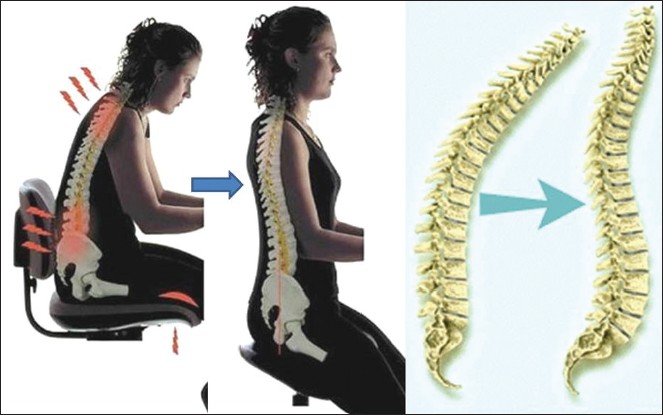  |
Ergonomics, posture and exercises - Painfree, prolong orthodontic career |
p. 89 |
Avesh Sachan, Vinay Kumar Verma, Sujit Panda, Karuna Singh
DOI:10.4103/2321-3825.123318 Orthodontists are exposed to several occupational hazards. Back and neck pain arising due to improper posture is very common in this community. The nature of work entails abnormal flexion of the lumber spine and subsequent loading on the inter-vertebral disks or extra tension in the spinous ligaments causing musculoskeletal disorders. Neck and shoulder, lower back, hand and wrist are the most commonly involved regions. Obtain an accurate diagnosis from a qualified healthcare provider. Early intervention is the key. Treatment may range from pain relief medications and rest to surgery and ergonomic interventions at work place and home. The current paper discusses etiology of musculoskeletal disorders (MSD) preventive measures which can be incorporated to ensure a trouble free professional career. |
| [ABSTRACT] [HTML Full text] [PDF] [Mobile Full text] [EPub] [Sword Plugin for Repository]Beta |
|
|
|
|
|
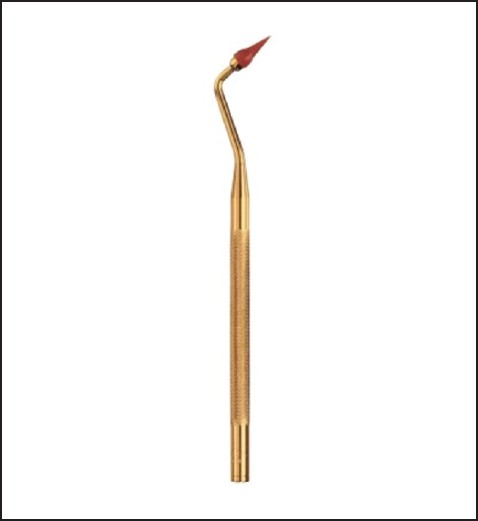  |
Orthodontic treatment considerations in hemophilic patients |
p. 95 |
Seyed Morteza Saadat Mostafavi, Soroush Moeini, Malihe Moeini, Navid Rezaei
DOI:10.4103/2321-3825.123319 Introduction: Orthodontic treatment reason improving the appearance, increased confidence and satisfaction, it seems that these treatments for patients with systemic diseases (for example, hemophilia) compared with normal subjects, can be useful. In this manuscript following are what special considerations for orthodontic treatment will be provided to these patients? Materials and Methods: Our searches were done by using keywords "hemophilia," "orthodontic treatment" and "bleeding disorder." Articles are from 1975 to 2012. All of them were searching through Google, Google scholar, Pub Med, Medline and Science Direct. Results: Orthodontic treatment does not increase the risk of bleeding in patients with hemophilia. These patients can also do orthognathic surgery. Two issues that need to be considered in the orthodontic treatment of hemophilia patients are: Iatrogenic viral infection, bleeding risk. Of course, each one has its own solution. Conclusions: People with hemophilia without any concern can be done orthodontic treatment. Even orthognathic surgery is no contraindications to them. |
| [ABSTRACT] [HTML Full text] [PDF] [Mobile Full text] [EPub] [Sword Plugin for Repository]Beta |
|
|
|
|
|
|
Timing of orthodontic treatment |
p. 99 |
Mahesh Jain, Nidhi Dhakar
DOI:10.4103/2321-3825.123320 General dental practitioners are the first to examine and screen children for developing malocclusions and hence they are most responsible for correct diagnosis and referral. They are often faced with the dilemma of deciding at what age to refer for a further opinion and treatment. This entirely depends on the problem that has been diagnosed and the dental state of the child, but there is always a question that is there an "ideal" time for orthodontic treatment, if the clinician wants to maximize the benefits of growth and development without subjecting every child to fixed mechanotherapy for years. The controversy surrounding early versus late orthodontic treatment is often frustrating and confusing to the dental fraternity. This article looks into both sides of the issue for orthodontic treatment of Class II and III malocclusions along with the problems in the transverse dimension and vertical dimension. Early orthodontic treatment is effective and desirable in specific situations. However, the evidence in the form of Randomized Control Treatment is equally compelling that such an approach is not indicated in many cases for which later, one-phase treatment is more effective and efficient. Therefore, dental practitioners must decide on the basis of their experience and clinical judgment when to advise orthodontic treatment. For many patients, delaying the treatment may be advisable to obtain advantage from dental and skeletal development. |
| [ABSTRACT] [HTML Full text] [PDF] [Mobile Full text] [EPub] [Sword Plugin for Repository]Beta |
|
|
|
|
|
|
| SHORT COMMUNICATION |
 |
|
|
|
Considerations for the orthodontic treatment during pregnancy  |
p. 103 |
Avesh Sachan, Vinay Kumar Verma, Sujit Panda, Karuna Singh
DOI:10.4103/2321-3825.123321 Pregnant women are advised against doing many things during their pregnancy, from taking certain types of medication, to eating some foods. However, there is no real reason why pregnant women should not have orthodontic treatment. For pregnant women orthodontic treatment is typically considered to be a safe, but with some precaution. Some local and systemic conditions limit the treatment modalities. There are some considerations for pregnant women to take into account. Sensitivity is often heightened during pregnancy and this may mean that braces seem a little more uncomfortable than usual; it is also worth bearing in mind that most painkillers are off-limits during pregnancy and hence patient will have to battle through any pain without taking medication. Hormonal changes in the body during pregnancy can increase the risk of swollen, sore gums and braces may irritate the gums. Hormonal changes and drugs can affect the orthodontic tooth movement. If patient have braces are pregnant and have concerns about their braces, it is important for patients to see their orthodontist on a regular basis during pregnancy. |
| [ABSTRACT] [HTML Full text] [PDF] [Mobile Full text] [EPub] [Sword Plugin for Repository]Beta |
|
|
|
|
|
|
| CASE REPORT |
 |
|
|
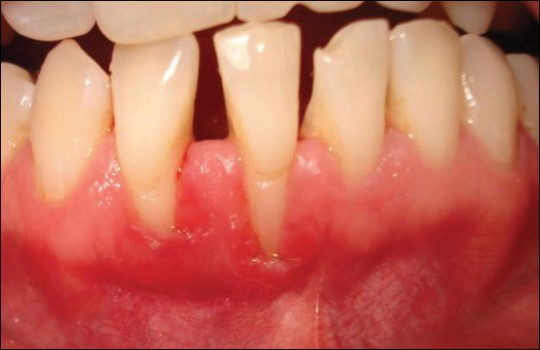  |
Periodontics and orthodontics team-work in the treatment of gingival recession: Two case reports |
p. 107 |
Arzu Alkan, Omer Cakmak, Ilhan Ramoglu, Gulsah Yagan, Banu KiliÁ
DOI:10.4103/2321-3825.123322 In this report, we presented two cases in which orthodontic treatment played the role both in the etiology and treatment of gingival recession at mandibular anterior teeth. Subepithelial connective tissue graft was used in order to cover the exposed root surfaces. Residual recession after mucogingival periodontal surgery was further reduced by orthodontic intrusion of the incisors in both of the cases. The periodontics and orthodontics team-work satisfied both patients and the clinicians from the point of maintaining periodontal health, ideal occlusal relationships and masticatory function despite the prolonged treatment period. |
| [ABSTRACT] [HTML Full text] [PDF] [Mobile Full text] [EPub] [Sword Plugin for Repository]Beta |
|
|
|
|
|
|
| LETTER TO THE EDITOR |
 |
|
|
|
Which is the future of the orthodontics? |
p. 113 |
KC Prabhat, Sandhya Maheshwari, Sanjeev K Verma
DOI:10.4103/2321-3825.123323 |
| [HTML Full text] [PDF] [Mobile Full text] [EPub] [Sword Plugin for Repository]Beta |
|
|
|
|
|